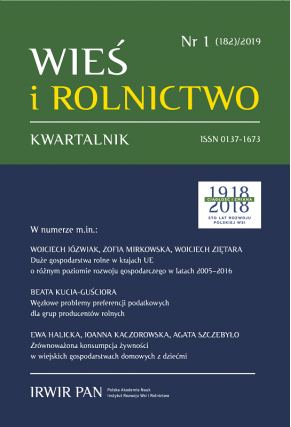Large Farms in EU Countries with Different Levels of Economic Development in 2005–2016
DOI:
https://doi.org/10.53098/wir012019/01Keywords:
agricultural holdings, arable land, agricultural production, land and labour productivityAbstract
The higher growth rate of labour costs in non-agricultural sectors and prices of means of production for agriculture from the prices of sales of agricultural products in countries with a market economy is causing a decrease in the unit profitability of agricultural production. Farmers who want to earn a satisfactory income must increase the scale of production, mainly by increasing the farm area. The research selected two groups of countries differing in the level of economic development determined by the value of gross domestic product (GDP) per capita. The justification for this choice was the existing dependence of the economic power of farms on the level of the national economy of the countries studied. The first group of countries with a high GDP included: Denmark, Sweden, Ireland, the Netherlands, Austria, Germany, Belgium, the United Kingdom, France, Slovenia, the Czech Republic, Slovakia, Lithuania, Latvia, Poland; the second included Hungary, Romania and Bulgaria. The analysis covered changes in the average area of farms, share of farms with an area of: 30 ha of agricultural land and larger in the total number of farms in land use, employment and standard production in the surveyed years 2005 and 2016. In countries in the 1st and 2nd group the average area of farms and the proportion of area-wide farms in land use and production had increased in the subsequent period. In the majority of the countries analysed, the proportion of farms with an area of 100 ha and larger in production exceeded 50%.
References
Brinkmann T. (1922). Die Ökonomik des landwirtschaftlichen Betriebes. W: T. Brinkmann, J.B. Esslen, K. Grüberg, H. Hausrath, H. Mauer, P. Moldenhauer, E. Wegener, W. Wittich, W. Wygodzinsky (red.). Grundriss der Sozialökonomik (s. 27–124). Tübingen: Verlag J.C.B. Mohr.
Czyżewski B. (2017). Kierat rynkowy w europejskim rolnictwie. Warszawa: Wydawnictwo Naukowe PWN.
Eurostat; http://ec.europa.eu/eurostat/data/database (dostęp: 24.04.2018).
Józwiak W., Mirkowska Z., Ziętara W. (2018). Gospodarstwa obszarowo większe w Polsce i w wybranych krajach Unii Europejskiej w latach 2005 i 2016. Maszynopis w Zakładzie Ekonomiki Gospodarstw Rolnych IERiGŻ–PIB. Warszawa: Instytut Ekonomiki Rolnictwa i Gospodarki Żywnościowej – Państwowy Instytut Badawczy.
Statistisches Jahrbuch über Ernährung, Landwirtschaft und Forsten 2015 (2016). Münster: Landwirtschafts Verlag.
Sikorska A. (2013). Przemiany w strukturze agrarnej indywidualnych gospodarstw rolnych. Warszawa: Instytut Ekonomiki Rolnictwa i Gospodarki Żywnościowej – Państwowy Instytut Badawczy.
Steffen G. (2001). Wielkość i organizacja rodzinnych gospodarstw rolniczych w Niemczech. Warszawa: Wydawnictwo Szkoły Głównej Gospodarstwa Wiejskiego.
Tomczak F. (2004). Od rolnictwa do agrobiznesu: Transformacja gospodarki rolniczo-żywnościowej Stanów Zjednoczonych Ameryki Północnej. Warszawa: Wydawnictwo Szkoły Głównej Handlowej.
Ziętara W. (2017). Pozycja konkurencyjna polskich gospodarstw z uwzględnieniem typów rolniczych. Roczniki Naukowe Stowarzyszenia Ekonomistów Rolnictwa i Agrobiznesu, 19 (3), 319–324.
Ziętara W., Adamski M. (2018). Konkurencyjność polskich gospodarstw mlecznych. Zagadnienia Ekonomiki Rolnictwa, 1, 56–79. DOI: https://doi.org/10.30858/zer/89615











